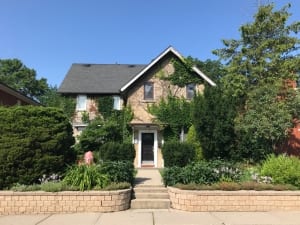I’m looking forward to a webinar about Toronto laneway houses; the webinar has prompted me to think about great design in general – as at 58 Wheatfield Road
I have an interest in tiny houses, laneway houses, and backyard studios. I’m looking forward to attending a webinar about laneway houses in May 2020, sponsored by the Architect Builders Collaborative Inc. I learned about the event on Twitter.
58 Wheatfield Road, Mimico
I was involved, along with many other heritage enthusiasts some months back during the pre-COVOID-19 era, in an extensive letter-writing project aimed at ensuring that a heritage house at 58 Wheatfield Road in Mimico in Toronto would qualify for designation under the Ontario Heritage Act, rather than being partially demolished. So, I will say a few words about my visit to that house earlier this year. It was my upcoming attendance at a Laneway Housing seminar via Zoom, that made me think about how much I enjoyed a visit to this outstanding heritage property in Mimico.
What prompts me to write about 58 Wheatfield Road is the fact that the concept of good design – including the design of a six-week home in the roots of a hemlock tree, and the design of all manner of experiences – appeals to me tremendously. The property in question in Mimico features architecture that is exquisitely well-planned and executed. I have never before encountered such an awesomely well-designed residential building. Beyond question, the visit to the house was an exceptional learning opportunity for me, for which fact I feel a tremendous sense of gratitude.
By visiting the house, I’ve learned something about the quality of early-1900s architecture that I (given my limited encounters with the experiential details, of early-1900s high-end architectural practices) otherwise would never have learned.
At previous posts, I’ve written about the story that goes with this astoundingly beautiful property. With close involvement (it takes energy and dedication to write a good letter) of a large number of Toronto residents, the house was saved from destruction, and has since then been renovated by an architectural firm that specializes in restoration of heritage properties.
When I first learned about the house, when I attended an event organized by Heritage Toronto, it would never have occurred to me that one day I would spend time actually visiting each floor of the building – including even a climb up into the attic, to have a look around.
In January 2020 I had the good fortune to spend several hours visiting the house and meeting with the new owners. I was absolutely amazed at how the house was designed. It was planned and laid out in such a way that, wherever you walked in the house, and from wherever you looked to the outside, everything was just right. It was an uncanny sensation – like driving a really good sports car. I’m really pleased I had the opportunity to visit the house – and experience first-hand the work of the architect Alfred Baker.
Connection to Stratford
As noted at a previous post:
“The large home at 58 Wheatfield Road (originally Robert Street) was built circa 1908 for Alfred Baker.
“Alfred Baker was born in Stratford, Ontario on July 13, 1877. He was the son of Ichabod Baker, a civil engineer with the Grand Trunk Railway and Carrie Matilda Smith. He apprenticed with the architect Harry J. Powell in Stratford in the late 1890s.”
The house we live in in Stratford is about the same age – built in the early 1900s – as 58 Wheatfield Road house. Our house is more a run of the mill design yet there are touches that, again, are just right. Among those touches is the sunroom on the second floor and the guest room where the entrance to the sunroom is located. Spending even a few minutes in such a space is inspiring, and just right.
Everything about the guest room and sunroom is absolutely apt. It was designed by a designer who knew how to set up a space so that no matter where you look, and no matter from where you view the street outside, all the possible things that a designer could think about, in terms of a person spending time in that space, have been taken into account.
The door trim and floorboards at our house are covered in over a century of layers of paint. There’s a lot to be said about stripping such a surface down and also much to be said about leaving it as it is. We’re leaving it as it is. The surfaces throughout the house appeal to me, just as they are. The windows have a wavy quality. When you look through the windows, things appear to shimmer. That’s how glass was made in those days. I like the glass, just as it is.


Leave a Reply
Want to join the discussion?Feel free to contribute!